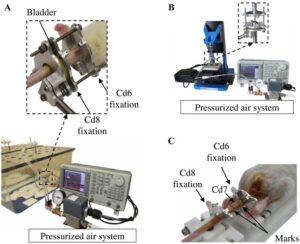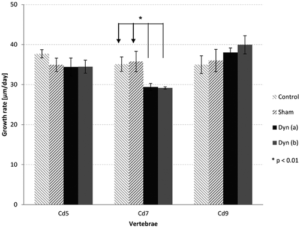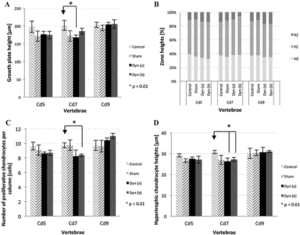Endochondral ossification is not the only mechanism by which one can grow taller but also by appositional growth on the longitudinal ends whether by articular cartilage endochondral ossification or by direct bone deposition. This study indicates that dinosaurs may have grown via non-endochondral ossification dependent mechanisms. {Edit: I emailed BM Rothschield and he said that all longitudinal bone growth identified occurred via longitudinal means but I think there’s a lot of interesting stuff here like that vascularization is key for growth plates.
An apparently phylogeny-independent method for identification of skeletal (longitudinal) growth cessation (skeletal maturity) in birds
“Identification of skeletal maturity is of interest as a measure of species longevity and for identifying its maximal achievable size/mass. Measurement of age on the basis of growth arrest/accentuation lines and external fundamental system evidences cessation or at least extreme slowing of circumferential bone growth{circumferential is appositional/periosteal growth which is mainly bone width but could potentially increase bone length albeit very slowly}. Such intramembranous (periosteal)-derived growth is distinct from the endochondral ossification responsible for longitudinal growth and therefore achievable organismal size/mass. As subchondral transcortical channels are required for nourishment, their loss should identify cessation of longitudinal growth{if we can restore subchondral transcortical channels then maybe we can restore longitudinal bone growth}. Predicated on phylogenetic bracketing/relationship and shared anatomical structures with and without growth plates, birds represent an appropriate model for the study of dinosaur ontogeny. Persistence of transcortical subchondral channels in the long bones of birds are examined at ×100–200 magnification and correlated with bone length. Transcortical channels are present in subchondral articular surfaces, but disappear when terminal longitudinal growth is achieved. Articular vascular channels perforating articular surfaces from within the bone are detected. Loss of penetrating channels is interpreted as evidence of skeletal growth cessation, identifying the longitudinal bone length at which skeletal growth cessation has been achieved. The current study provides evidence that maximal bone length does correlate with endochondral cessation growth. Failure of circumferential growth reduction/cessation to correlate with bone length may be related to lack of synchronicity of periosteal-based circumferential growth with the endochondral process responsible for bone lengthening{so the author states that circumferential growth can contribute bone length potential but it does not happen in practice}. Loss/closure of articular vascular channels may be the most reliable measure of a bird’s achievement of maximal growth (indicating cessation of appendicular element lengthening).”
“As trans-cortical channels through subchondral (that just below the articular cartilage) bone are the major source of nutrients for continued longitudinal growth, it is hypothesized that atrophy or loss of those articular vascular channels would preclude continued growth of bone – at least longitudinally.”<-this may be why mechanical loading could contribute to longitudinal bone growth by making this delivery more efficient by driving nutrients and potentially stimulating the channels to be open for longer
“Even calcified cartilage (which persists in the long bones of some groups) retains trans-surface (articular) channels (Rothschild and Tanke, 2007) and represents the opportunity for continuing growth“<-BM Rothschild the author of this study has also studied dinosaur bones
” epiphyseal bone expands “into the cartilage anlage until the interface forms a calcific layer that arrests vascular invasion.” That shuts off the marrow, and the vascular supply thereby available, from the epiphyseal cartilage”<-if we can degrade that layer then we can restore longitudinal bone growth
““proximal end of humerus grows faster than distal, “because the internal pattern of spongiosum depends on the direction of bone pressure.””<-thus again that bone pressure can affect bone growth.
“Trans-articular surface canals (articular vascular channels perforating articular surfaces from within the bone marrow) are detected, independent of avian order or family, confirming loss of the blood supply necessary for longitudinal growth.”<-so we if can keep the blood supply than we can keep growing for longer. Note distraction osteogenesis basically restores the blood supply via fracture
” “canal-like contacts between the articular cartilages and the medullary cavities of epiphyses” supports the interpretation that continued growth is dependent upon persistence of such channels. While the loss of articular vascular channels does not identify an individual’s actual age, it does allow identification of the longitudinal bone length at which skeletal growth cessation has been achieved.”
“a linear relationship between LAG/EFS{growth arrest lines} and bone length is not established in dinosaurs. However, there is a confounding issue: Circumferential growth is the result of intramembraneous (periosteal) bone formation, while bone lengthening is the product of a very different process, endochondral bone formation”<-meaning dinosaurs were likely able to grow via mechanisms other than longitudinal bone growth.
” Longitudinal histologic section of bones provides evidence that growth had ceased, at least by documenting loss of trans-cortical channels. It is unclear that such a histological approach would provide significant additional information (on longitudinal growth cessation) to that observed by microscopic examination of joint surfaces. At this time, loss/closure of articular vascular channels may be the most reliable measure of a bird’s achievement of maximal growth (indicating cessation of appendicular element lengthening)”
Here’s more on dinosaurs also by BM Rothschild
Identification of growth cessation in dinosaurs based on microscopy of long bone articular surfaces: preliminary results
“As applied to bone, ‘determinate growth’ identifies an upper limit to size and the point when normal endochondral ossification ceases. This contrasts with ‘indeterminate growth’, which proceeds through the entire life of the animal. In this study, a non-destructive method, epi-illumination surface microscopy of the articular surfaces of long bones, is applied for the first time in 40 taxa of non-avian dinosaurs to determine cessation of endochondral growth. Thereby, the presence or absence of articular vascular channels between the endochondral bone and the cartilage is assessed. As articular vascular channels are the major source of nutrients for continued longitudinal growth, atrophy or loss of those channels would preclude continued growth of bone. We correlated our findings with published histological data and bone length measurements. We found articular vascular channels in all assessed dinosaur groups, but some individuals showed a loss of detectable articular vascular channels – what we interpret as evidence of longitudinal skeletal growth cessation. This observation contrasts with the hypothesis of continuous indeterminate growth in dinosaurs, at least for the taxa identified here, in which channels have been documented as closed or closing over{so dinosaurs must have grown via mechanisms other than endochondral ossification}. The new method introduced here provides a phylogenetic tool for definitively distinguishing new ‘dwarf’ species from juveniles of known species. Furthermore, this study confirms the rarity of skeletally mature dinosaurs discovered to date and indicates that we have only begun to witness the full extent of dinosaur growth.”
“Growth measured by LAGs and by EFS is intramembranous in derivation. It is a very different process from the endochondral ossification (in which bone replaces cartilage), which characterizes longitudinal bone growth”
“trans-cortical channels through subchondral (i.e., just below the articular cartilage) bone are the major source of nutrients for continued longitudinal growth, it is hypothesized that atrophy or loss of those articular vascular channels would preclude continued growth of bone—at least longitudinally. Even calcified cartilage (which persists in the long bones of some dinosaur groups) retains trans-surface (articular) channels and represents the opportunity for continuing growth{!}.”
“epiphyseal bone expands ‘into the cartilage anlage until the interface forms a calcific layer that arrests vascular invasion’. This shuts off the marrow, and the vascular supply thereby available, from the epiphyseal cartilage”
” in [some] taxa (e.g., Plateosaurus) the bone length is not correlated with ontogeny as measured by slowing/cessation of intramembraneously based circumferential growth”
“failure to identify growth cessation in Tyrannosaurus rex.”



